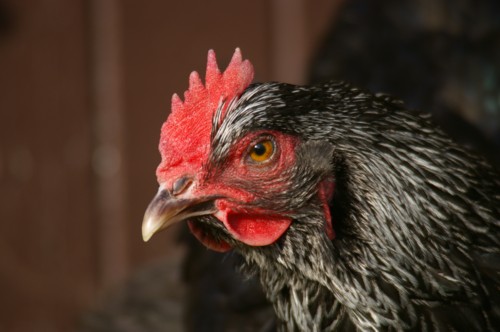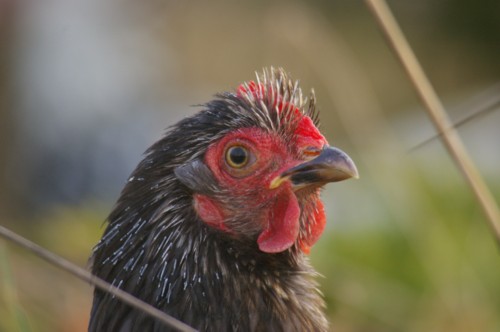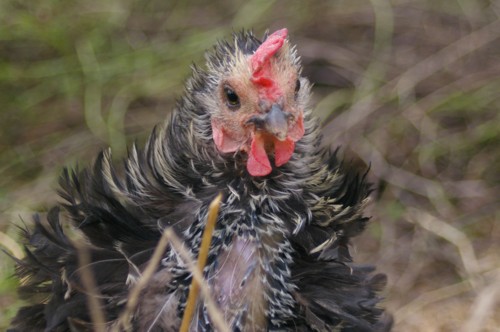Heidie, Grey and Lace
Heidie is sweet, oh so sweet. You can already see that in her eyes. She wouldn’t hurt a fly, (as a figure of speech of course!) Heidie is what they call here a Niederheimer. A short history: before the introduction of the current meat birds, in 1940 Germany needed to develop a fast growing meat bird. They crossed the Dutch Noord-Hollandse hen, with amongst others the Mechelse Koekoek, the Orpington and the Plymouth rock. What’s quite funny about her appearance is that she's square, like a box.
The Niederheimers are quiet, curious and can become very tame. When I spend my little hour with the chickens she’s always the first to be seen, coming up to me to see whether she can get something to eat. And that is the drawback of this breed. Because they can put on quite some weight they need a lot of space with sufficient exercise.
Heidie Date of birth: May 2008

Grey’s name fitted
her to a “t” as she was always a
modest little hen. She didn’t really stand out amongst her colourful
brothers
and sisters. But we will never forget the last days of her life.
In February 2009 Grey was very sick. She had a swollen belly, was
breathing
rapidly and had diarrhoea. We tried to cure it with medicines and
natural remedies,
I won’t go into the details. But they didn’t work very well. And what
can you
do in such a case? Usually you go to the vet and ask for it to be put to
sleep.
Sometimes it is quietly heading that way, but sometimes you notice that
the
animal is still not ready for it. So this time we wanted to do it
differently.
Grey stayed with us to her very last breath. Even though she was very
weak, she
still ate sweetcorn and a piece of bread. And,
almost as if she knew that it was for the
last time, the very afternoon of her death, she exposed her frail body
to
the first rays of the spring sun, while birds were merrily
whistling in the garden. But then
suddenly it went very fast.
This is what I wrote to a friend about the final moments of her life:
"I've done what you suggested. I had a towel on her to keep her warm. I
rolled her in it and while I was lying on the bed, she was nice and
comfy on my
tummy. I was almost asleep when my husband came to see if everything was
OK. I put
her back on her cushion next to our bed. She slept. I noticed that she
had
pooped and wanted to replace her towel. While I was doing that, I saw
that
she was going. She turned her head and suddenly she had her eyes wide
open. Just
for a few seconds and then they slowly closed and my flower was gone.
Very
peacefully."
I was happy and sad at the
same time. I will miss her. The bond is really big, when you are so busy
with them. And just like that, they leave you. But I am so glad
that I didn’t go to the vet for her final injection. It all went so
peacefully.
That’s how every being on earth should die.
Grey is a Cochin Bantam.
Grey Date of birth: 27th of August 2005

Back to April 2008. We had just lost a chicken due to egg peritonitis. This is an infection as a
result of an egg falling into the abdomen cavity. As Lace was trying to lay but
no egg appeared, I was worried she could have the same. A friend suggested giving Lace Sepia as her chicken was cured by it. Since then Lace seems a lot happier and does not want to lay eggs anymore.
For a long time she lived with her cockerel Pasja in a separate bit of the garden. Every evening they came inside. Lace had developed poor eyesight. She had cataracts. Unfortunately, due to a terrible accident, Lace left us in the beginning of May 2009.
When you have animals you know one day they will have to leave you. I have already lost quite some chickens due to different causes. But loosing Lace was a hard nut to crack. I will never forget her. Lace is a frizzle Cochin Bantam
Lace Date of birth: 6th of May 2006
